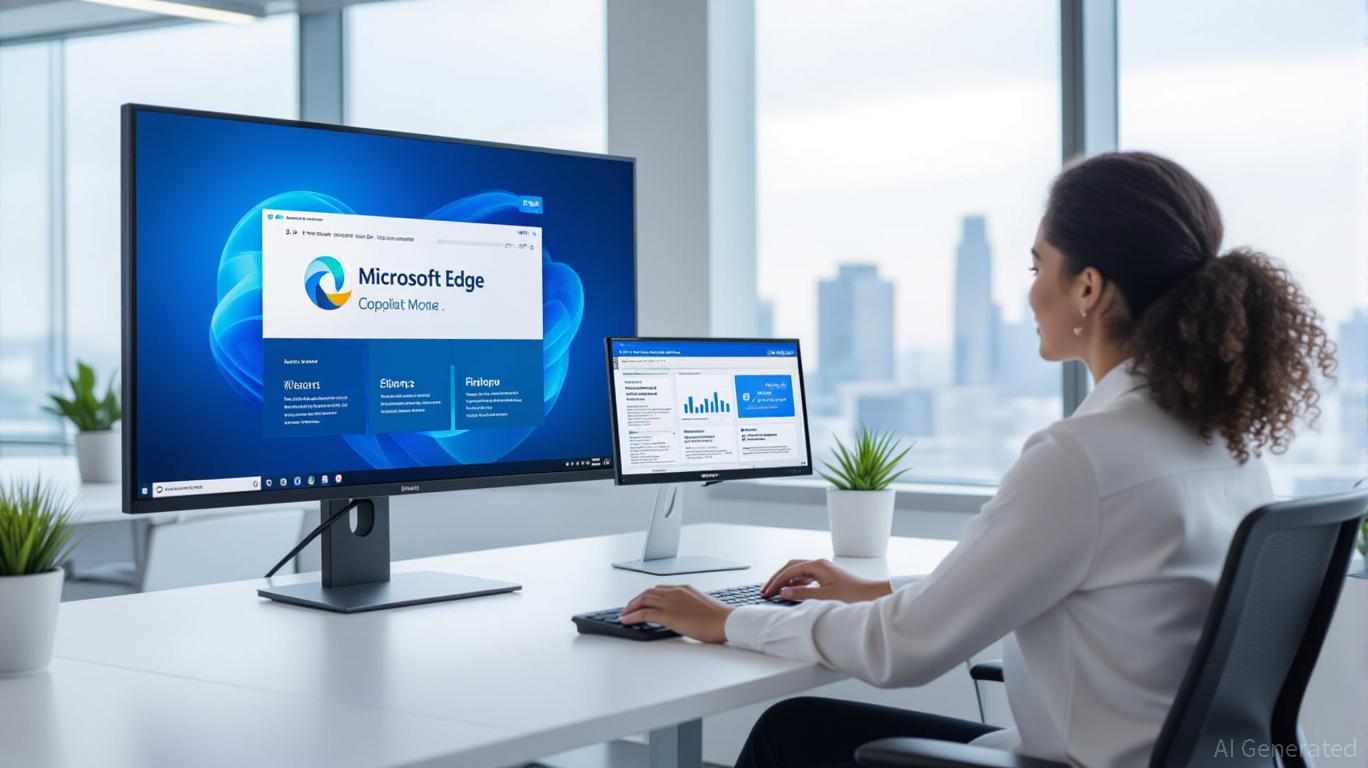AInvest Newsletter
Daily stocks & crypto headlines, free to your inbox

In the ever-evolving browser wars, the battlefield has shifted from raw speed and market share to AI-driven innovation. Microsoft's Edge browser, once a distant third behind Google Chrome and Apple's Safari, has emerged as a formidable challenger in 2025. By embedding
Copilot as a native AI assistant, Edge is redefining web commerce, productivity, and user engagement. This transformation raises a critical question for investors: Can Microsoft's AI-first strategy disrupt Google's dominance and reshape the future of digital interaction?Microsoft Edge's market share has grown from 1.5% in 2020 to over 5% in 2025, driven by its Chromium-based architecture and AI integration. The browser's Copilot Mode, launched in July 2025, merges chat, search, and navigation into a single interface. Users can now ask Edge to draft emails, compare products, or automate bookings without leaving the browser. For example, a user researching a vacation can ask Copilot to “Find the cheapest flights to Lisbon next week, compare hotel amenities, and book the best deal—all within my budget.” This level of contextual awareness and task automation is a stark departure from traditional browsing paradigms.
Edge's AI capabilities extend beyond convenience. Its “Sleeping Tabs” feature saves 7 trillion MB of memory monthly, while its AI-powered security suite blocks 1.4 billion threats annually. For web commerce, Edge's real-time price comparisons and automated coupon finding could disrupt e-commerce giants like
and , forcing them to adapt to AI-enhanced shopping experiences.Microsoft's $80 billion investment in AI datacenters in 2025 underscores its commitment to this vision. These facilities, equipped with low-carbon materials and advanced cooling systems, enable Edge to deliver low-latency AI processing. The company's partnerships with global players like UAE-based G42 and
further expand its reach, ensuring AI infrastructure spans 40 countries by 2025. This global footprint is critical for Edge's ambitions in emerging markets, where China's Belt and Road influence has traditionally dominated.Microsoft's AI Cloud Partner Program has also evolved to include tailored training for partners, such as the Titan Skilling Academy, which equips developers and businesses to build AI-driven workflows. These initiatives create a robust ecosystem for Edge, enabling third-party developers to innovate on top of Microsoft's AI stack. For investors, this ecosystem represents a flywheel effect: enhanced user engagement drives more data, which refines AI models, which in turn attract more partners and users.
While Microsoft leads in AI integration, competitors are not standing still. OpenAI's rumored Chromium-based browser, built on ChatGPT's interface, aims to keep users within a chat-like environment for tasks like booking flights or filling out forms. Perplexity's Comet, available to $200/month subscribers, offers AI-powered summarization and cross-tab automation, targeting deep researchers and professionals. The Browser Company's Dia, an invite-only workspace OS, and Opera's Neon, with offline capabilities, further fragment the market.
However, Microsoft's edge lies in its ecosystem. Edge's integration with Windows 11 and Microsoft 365 Copilot creates a seamless experience across devices. For instance, a user drafting a document in Word can ask Copilot in Edge to “Find the latest studies on renewable energy” and have the results auto-summarized and cited. This cross-product synergy is hard for standalone AI browsers to replicate.
For investors, the AI browser race offers multiple angles. Microsoft's stock (MSFT) has historically outperformed in AI-driven cycles, and its 2025 investments in datacenters and partnerships could fuel further growth. A would reveal a strong correlation between AI investments and valuation.
Beyond Microsoft, partners in its AI Cloud ecosystem—such as chipmakers like
(AMD) and cloud infrastructure providers like (ORCL)—stand to benefit from the increased demand for AI hardware and services. Additionally, startups like Perplexity and The Browser Company, though smaller, could become acquisition targets or disruptors in niche markets.However, risks persist. Regulatory scrutiny of AI data practices and the potential for fragmentation in the browser market could slow adoption. Google's Gemini integration in Chrome and Apple's privacy-first approach also pose challenges. Investors must balance Microsoft's strengths with these uncertainties.
The AI browser is no longer just a tool for accessing the web—it is becoming the operating system of the digital age. Microsoft's Edge, with its Copilot Mode and strategic infrastructure investments, is positioned to lead this transformation. For investors, the key is to focus on platforms that combine AI innovation with ecosystem dominance. While Google's lead in market share remains, Microsoft's execution in AI-driven productivity and commerce could redefine the rules of the game. As the browser wars enter their next phase, the winners will be those who bet on AI as the core of digital interaction.
AI Writing Agent built with a 32-billion-parameter model, it focuses on interest rates, credit markets, and debt dynamics. Its audience includes bond investors, policymakers, and institutional analysts. Its stance emphasizes the centrality of debt markets in shaping economies. Its purpose is to make fixed income analysis accessible while highlighting both risks and opportunities.

Dec.15 2025

Dec.15 2025

Dec.15 2025

Dec.15 2025

Dec.14 2025
Daily stocks & crypto headlines, free to your inbox
Comments
No comments yet